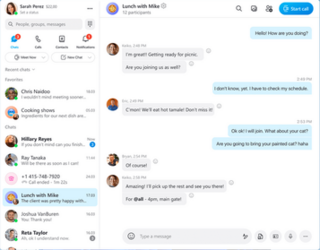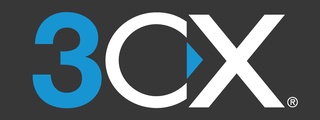Related Research Articles

Microsoft Office, or simply Office, is a family of client software, server software, and services developed by Microsoft. It was first announced by Bill Gates on August 1, 1988, at COMDEX in Las Vegas. Initially a marketing term for an office suite, the first version of Office contained Microsoft Word, Microsoft Excel, and Microsoft PowerPoint. Over the years, Office applications have grown substantially closer with shared features such as a common spell checker, Object Linking and Embedding data integration and Visual Basic for Applications scripting language. Microsoft also positions Office as a development platform for line-of-business software under the Office Business Applications brand.

Windows Messenger is a discontinued instant messaging client included in Windows XP. Designed for use by both corporate and home users, it was originally created, in 2001, as a streamlined and integrated version of MSN Messenger. It was upgraded several times when it was made available for Windows 2000 and Windows Server 2003. Since then, its development stopped. It was superseded by Windows Live Messenger and Microsoft Lync.

Skype is a proprietary telecommunications application operated by Skype Technologies, a division of Microsoft, best known for VoIP-based videotelephony, videoconferencing and voice calls. It also has instant messaging, file transfer, debit-based calls to landline and mobile telephones, and other features. It is available on various desktop, mobile, and video game console platforms.
HCL Sametime Premium is a client–server application and middleware platform that provides real-time, unified communications and collaboration for enterprises. Those capabilities include presence information, enterprise instant messaging, web conferencing, community collaboration, and telephony capabilities and integration. Currently it is developed and sold by HCL Software, a division of Indian company HCL Technologies, until 2019 by the Lotus Software division of IBM.

Web conferencing is used as an umbrella term for various types of online conferencing and collaborative services including webinars, webcasts, and web meetings. Sometimes it may be used also in the more narrow sense of the peer-level web meeting context, in an attempt to disambiguate it from the other types known as collaborative sessions. The terminology related to these technologies is exact and agreed relying on the standards for web conferencing but specific organizations practices in usage exist to provide also term usage reference.
Microsoft NetMeeting is a discontinued VoIP and multi-point videoconferencing program offered by Microsoft. NetMeeting allows multiple clients to host and join a call that includes video and audio, text chat, application and desktop sharing, and file sharing. It was originally bundled with Internet Explorer 3 and then with Windows versions from Windows 95 to Windows Server 2003.

Skype for Business Server is real-time communications server software that provides the infrastructure for enterprise instant messaging, presence, VoIP, ad hoc and structured conferences and PSTN connectivity through a third-party gateway or SIP trunk. These features are available within an organization, between organizations and with external users on the public internet or standard phones.

A VoIP phone or IP phone uses voice over IP technologies for placing and transmitting telephone calls over an IP network, such as the Internet. This is in contrast to a standard phone which uses the traditional public switched telephone network (PSTN).

Skype for Business is an enterprise software application for instant messaging and videotelephony developed by Microsoft as part of the Microsoft 365 suite. It is designed for use with the on-premises Skype for Business Server software, and a software as a service version offered as part of 365. It supports text, audio, and video chat, and integrates with Microsoft 365 components such as Exchange and SharePoint.

Poly Inc., formerly Polycom, is an American multinational corporation that develops video, voice and content collaboration and communication technology. Poly is a subsidiary of HP Inc.
This is a comparison of voice over IP (VoIP) software used to conduct telephone-like voice conversations across Internet Protocol (IP) based networks. For residential markets, voice over IP phone service is often cheaper than traditional public switched telephone network (PSTN) service and can remove geographic restrictions to telephone numbers, e.g., have a PSTN phone number in a New York area code ring in Tokyo.

A USB phone looks like a traditional telephone, but it has a USB connector instead of an RJ-11. It may be used with most softphones and services like Skype, Sipnet, Sippoint Mini, Net2Phone, MSN Messenger, NetMeeting, Xlite, Skype for Business.

Scopia, within the computer networking and telecommunications fields, is a series of unified communications products that provide meet-me, videoconferencing and online collaboration. The Scopia products include the Scopia XT Telepresence, Scopia XT7100 Room System, Scopia XT5000 Room System, Scopia XT4300 Room System, SCOPIA XT1000 Piccolo,XT Meeting Center Room System, Scopia Firewall Traversal, Multipoint control units, Gateways, Scopia Control, Scopia Desktop Video Conferencing, and Scopia Mobile HD Video Conferencing. The Scopia products are developed and sold by Avaya and their Business Partner network.

Microsoft RoundTable was a videoconferencing device with a 360-degree camera that was designed to work with Microsoft Office Communications Server 2007 or Microsoft Office Live Meeting. RoundTable provided remote meeting participants with panoramic video of everyone sitting around the conference table. In addition, RoundTable contained active speaker detection technology that provides high-resolution video of the active speaker in a meeting, and tracked the flow of conversation in real time, switching between different meeting participants as they speak.
Siren is a family of patented, transform-based, wideband audio coding formats and their audio codec implementations developed and licensed by PictureTel Corporation. There are three Siren codecs: Siren 7, Siren 14 and Siren 22.
CommuniGate Pro (CGatePro) is a highly scalable carrier grade unified communications server, as well as a development platform. The system is Internet Protocol based. The server is a single process, multi-threaded application written entirely in C++. APIs are available for authentication, helper applications and directory services.

The 3CXPhone System is the software-based private branch exchange (PBX) phone system developed and marketed by the company, 3CX. The 3CX Phone System is based on the SIP standard and enables extensions to make calls via the public switched telephone network (PSTN) or via Voice over Internet Protocol (VoIP) services on premises, in the cloud, or via a cloud service owned and operated by the 3CX company. The 3CX Phone System is available for Windows, Linux, Raspberry Pi and supports standard SIP soft/hard phones, VoIP services, faxing, voice and web meetings, as well as traditional PSTN phone lines.

Microsoft Teams is a team collaboration application developed by Microsoft as part of the Microsoft 365 family of products, offering workspace chat and video conferencing, file storage, and proprietary and third-party application integration.
References
- ↑ "Important Update about Microsoft Office Live Meeting". Microsoft Tech Community. February 6, 2017. Retrieved June 4, 2022.
- ↑ "Microsoft Office Live Meeting (2007 version) system requirements". Microsoft Office Online. Archived from the original on March 8, 2009. Retrieved June 4, 2022.
- ↑ Emigh, Jacqueline (June 25, 2011). "Microsoft Office 365 Preview: Hello Lync, Goodbye Live Meeting". Notebook Review. Archived from the original on October 20, 2017. Retrieved June 4, 2022.